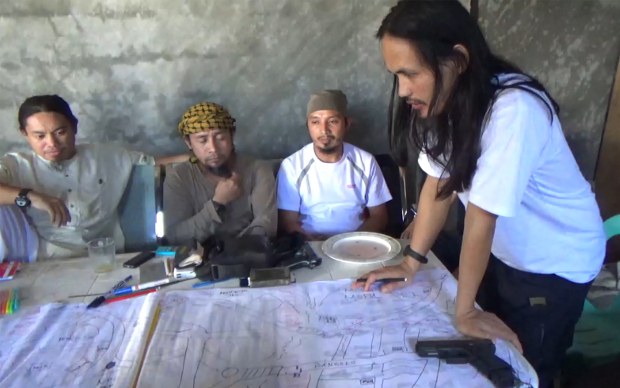Highly Skilled Malaysian IS Operative Knows Secret Routes Out of Marawi: Official
2017.06.29
Kuala Lumpur
 This screen shot from a video released by the Philippine army shows militant leader Abdullah Maute (right) standing over an improvised map of Marawi as Isnilon Hapilon, the proclaimed leader of Islamic State in the Philippines (second from left) looks on.
This screen shot from a video released by the Philippine army shows militant leader Abdullah Maute (right) standing over an improvised map of Marawi as Isnilon Hapilon, the proclaimed leader of Islamic State in the Philippines (second from left) looks on.
A top Malaysian militant and ex-university lecturer who reportedly escaped from the besieged southern Philippine city of Marawi is skilled at bomb-making, seamanship and languages and knows secret escape routes, a senior official with Malaysia’s counter-terrorist police branch said Thursday.
Suspect Mahmud bin Ahmad, an Islamic State (IS) operative, may have fled by sea to nearby Malaysian Borneo or Sulawesi island in Indonesia along with other militants and Isnilon Hapilon after evading troops that encircled Marawi for more than a month, according to the source. Hapilon is a Filipino recognized as the leader of IS’s affiliate in the Philippines.
“They and Isnilon Hapilon know the way in and out better than the Philippine army. There were too many secret sea routes that they could have taken. They have had this planned for a very long time,” the official told BenarNews on condition of anonymity.
He said those routes were well known to Abu Sayyaf Group (ASG) militants – with which Hapilon is associated – and two brothers who lead the Maute gang that has backed ASG and IS-linked foreigners in occupying parts of Marawi since late May.
Mahmud associated himself with Hapilon because the Filipino had extensive experience and was determined to pursue IS’s agenda in Southeast Asia, according to the source. He said Mahmud learned about building bombs and seafaring during his time with Hapilon.
“Besides being a bomb expert and a seaman, Mahmud is also very proficient in the dialects used by the Philippines militants, apart from the other languages he has mastered such as Malay, English and Arabic,” the source said.
Mahmud, a former professor of Islamic studies at Malaya University, Malaysia’s oldest institution of higher learning, is also among the most skilled militants who could take over from Hapilon in the event of the Filipino’s death, the source added.
“He is a smart guy,” the official said of Mahmud.
Radicalized intellectual
Early on in his career as a militant, the former professor undertook military training in Afghanistan and studied in Pakistan, where he joined the ranks of al-Qaeda, according to newspaper accounts of Mahmud’s life.
More recently, Philippine military officials accused Mahmud, who is in his late 30s, of raising money to finance IS’s war effort in Marawi, which is the first city in the Asia-Pacific region to have been occupied Islamic State-linked fighters.
Before he left Malaysia, Mahmud recruited compatriots to join IS’s fight in the Middle East, including Ahmad Tarmimi Maliki, the first Malaysian suicide bombers killed in Iraq, according to Rohan Gunaratna, a Singapore-based expert on terrorism in Southeast Asia.
“Together with his closest associate, the late Najib Hussin, Mahmud united disparate Muslim groups to create [the] IS East Asia Division. … Mahmud planned to develop the eastern Malaysian state of Sabah as a transit point for South Asian and Southeast Asian recruits to train and fight in the Philippines,” Gunaratna, who directs the International Center for Political Violence and Terrorism Research, wrote in a column for BenarNews this month.
‘He is still alive’
Last week, Philippine officials said they had received reports that Mahmud and Omarkhayam Maute, one of the brothers who leads the Maute gang, possibly were killed in the fighting in Marawi.
Philippine authorities said Mahmud had been seen with Hapilon in a video obtained by the military showing them and other men plotting an IS takeover of Marawi.
On June 25, Malaysian police chief Khalid Abu Bakar said his department obtained information that both Mahmud and Hapilon were alive.
“Philippine authorities informed us that Isnilon Hapilon is believed to have escaped Marawi, so most probably Dr. Mahmud is with him. We cannot confirm that, but a friend in the Philippines told us that he is still alive,” the New Straits Times newspaper quoted Khalid as saying.
When asked about where the two may have fled, the anonymous security source said they could be anywhere, including the eastern Malaysian state of Sabah. It lies across the Sulu Sea from the southern Philippine island of Mindanao, where Marawi is located.
“That includes Sulawesi, an Indonesian island east of Borneo, a route that used to be used by the Jemaah Islamiyah militant group to travel between Sulawesi and southern Philippine islands. Sabah is also one of the possibilities,” the source told BenarNews.
On June 22, officials from the Philippines, Malaysia and Indonesia agreed at a meeting in Manila to closely coordinate their efforts to prevent militant fighters and weapons from spilling across their mutual borders. Last week, the countries also launched joint patrols to safeguard their common seaways between Sabah and Mindanao.
“The scenario of where he had escaped with Hapilon to leave the siege would certainly be used as propaganda to show their strength against the Philippines forces,” Azmi Hassan, a professor of geo-politics at Universiti Teknologi Malaysia told BenarNews, referring to Mahmud bin Ahmad.
“What is more worrying is that this escape would raise the spirit of Daesh supporters in the country,” he added, using another name for Islamic State.
Hata Wahari in Kuala Lumpur contributed to this report.







